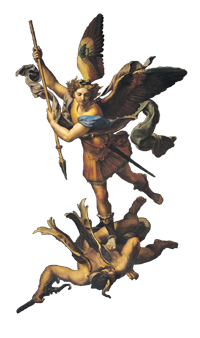An Origin of Free Will and Evil

Tracing reality from the singular Idea as it became a being and ultimately a universe — subsequently giving expression to independent ideas acting under their own wills as beings — suggests that reality is fundamentally conceptual, not material. It is fundamentally purposeful, or teleological, rather than sequential, or consequential. The metaphorical scheme to describe such a reality should therefore shift from the simple geometry used to visualize the relationship of the core concepts of Idea, Expression, and mutual Awareness to a metaphor associated with ideas themselves: language.
In this context, it is more relevant and more crucial to understand that we are merely using a metaphor to describe a concept. With quantum physics, for example, we should by now have realized that the idea of “particles” is, itself, a metaphor — one that imperfectly describes the strange ways in which these things act. This point we’ll put aside for a future essay, raising it only to emphasize the distance between language as a practical tool to describe reality accurately in our everyday lives and language as an approximate representation of a reality that is fundamentally conceptual.
Consider a book. The initial utterance that brought everything into reality — “Be” — is like the title of a book to the unfathomably brilliant person who has every word memorized and has understood it completely. The relationship of the Idea to the Expression (the Father to the Son) is a total and perfect communication whereby each knows in its entirety and simultaneity everything that “Be” signifies.
As the Being who is reality describes Himself to Himself in ever-greater detail, the separation of detail from the whole creates distinct beings. Each lower being, in focusing upon details, is no longer the Being who observes it all simultaneously, and in this way, free will arises as the choice of which detail to observe and in what sequence. The observation, the experience, and the resulting relationship with God (the unity) can differ. Each being remains an expression of God, and a participant in God’s experience of His Creation, but they cannot be God, because aspects of His Idea are unknown to them.
At one step of remove, these beings observe and understand God’s Idea at a level akin to unit headings in a textbook. They understand each unit in its entirety, all at once, but not the whole book. At this level, perhaps they are not eternally distinct; perhaps, like the explosions of flares arching from a star and falling back into it, drawn by gravity and other forces, an understanding at the level of units can collect into understanding of the entire concept of the book as the beings are drawn toward and achieve unity with the Idea. Or perhaps they remain held apart by the ontological level of observation.
Another complicated, but crucial, point emerges from the concept of beings drawn toward the unity of God. Namely, all of reality is a relationship, beginning with the mutual Awareness of the totalized Idea and its Expression. Each lesser being chooses to observe an aspect of the Multiverse (as already defined), and God expresses the Universe in response, so as to be observed in that aspect. That is, every moment is the experience of the being and its relationship with God, who is also experiencing every possible moment all at once. If a being is able to achieve perfect unity with God — meaning that it achieves the ability to experience the Universe in totality — then it becomes indistinguishable from, and therefore identifiable as, God.
Be that as it may, the layers of conceptual detail continue, and at some threshold, beings must become permanently independent because they cannot fully conceive of the whole. Within the units are beings who understand reality at the level of chapters. And then sections. And then paragraphs, followed by sentences, followed by phrases, followed by words. At the lowest level come the letters.
The metaphor stops with letters for two reasons. First, the next step would bring us into the creation of the text, its substance, and that represents a distinct aspect — the distinction between the message and the medium. Whether the message explains the medium or the reverse — that is, whether the medium exists in order to convey the message or the message appears as a consequence of the medium — is a question to which we’ll return down the road. For the moment, our emphasis is on understanding the notion of a text as a metaphor. Beings at the level of letters in the metaphor are not literally letters, so we can decide later whether and how the metaphor extends to ink and paper.
Second, taking care to stay within the frame of concepts, letters must be the base. They are the baseline of intention, of significance, of a non-incidental action to convey meaning. By whatever method the letters are made, they are the primary indicator of shapes being made deliberately with the intent to convey an idea.
Nonetheless, beings at the level of letters — human beings — can only glean meaning by stringing letters into words or maybe, if we strive and work together and build on each other’s discoveries, into phrases and sentences. In truth, we can’t even be sure which direction we’re supposed to read across the page, which makes it plausible for some to conclude that there is no such thing as coherent meaning.
With the metaphor drawn out in this way, we can think of angels and demons as beings at the level of words. Words allow no ambiguity as to whether meaning exists. A word is conceptual in its essence, unlike letters, which are arbitrarily drawn to construct a word. Yet, words can still be read across the page, rather than along the intended sentences, which is to say, they can convey a meaning contrary to God’s intent.
Evil ― which is the pursuit and construction of a meaning contrary to God’s nature ― enters reality in this way. While God is good, as is His Creation, independent wills can construct their own meaning using the substance He provides in ways that He did not intend.
At all levels of conception, the initial pattern of God replicates for all beings: idea, expression, and awareness. Each being is defined as the full set of its potential actions (meaning its potential observations of reality at its level) and its experience of choosing among them as an expression of unique will. In these terms, the greater the willfulness of reading across the page, the greater the sin.
Adam and Eve, as their Original Sin, realized that they could controvert God’s will, but that only set them adrift. In contrast, the serpent acts to convert God’s story into his own, as lunatic as it may be ― as lunatic as it must be by definition — so as to represent something separate from God and the Devil’s own. As the ancient story of the Fall also hints, it is not enough to be evil alone. To make a being’s distorted reality real, it must be shared in experience by others.
Put differently, others must aggregate their beings to the false reality because it is the observation that makes a moment real by means of the relationship between the Creator and the observer. The project of evil is to hijack the very essence of God — the beings who, as limited expressions of Him, make the Universe real in relationship with Him — to express a will that is not His.
Featured image by Vincent van Gogh on WikiArt.


